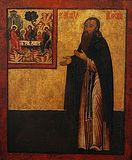

| Previous day | Next day |
| Old Style
January 11
|
Tuesday |
New Style
January 24
|
| 33rd Week after Pentecost. Tone 7. | No fast.
|
![]() Afterfeast of the Theophany.
Afterfeast of the Theophany. ![]() St. Theodosius the Great, the Coenobiarch (529).
St. Theodosius the Great, the Coenobiarch (529). ![]() St. Michael of Klops Monastery (Novgorod), fool-for-Christ (ca. 1453-1456).
St. Michael of Klops Monastery (Novgorod), fool-for-Christ (ca. 1453-1456).
St. Theodosius, ascetic of Rhosus and Antioch (ca. 412).
New Hieroconfessor Vladimir (Khirasko), archpriest, of Minsk (1932).
Chernigov-Eletskaya Icon of the Most Holy Theotokos (1060).
Hieromartyr Hyginus, pope of Rome (142). St. Stephen of Placidian near Constantinople. St. Agapius of Apamea in Syria. St. Theodosius of Mt. Athos, metropolitan of Trebizond (14th c.). St. Vitalis of the monastery of Abba Seridus at Gaza (609-620). St. Romilus, hermit, of Veddin (1375). St. Joseph of Cappadocia.
Repose of Blessed Nun Eupraxia of Teliakov village, Kostroma (1823).
Thoughts for Each Day of the Year
According to the Daily Church Readings from the Word of God
By St. Theophan the Recluse

Tuesday. [James 3:1–10; Mark 11:11–23]
The Lord took away His blessing from the fig tree which was rich with leaves but had no fruit, and it dried up. This is a lesson in action. The fig tree represents people who in appearance are proper, but in essence are not worthy of approval. Who are these people? They are those who eloquently discourse about the faith, but do not have that faith—they hold the objects of faith in the intellect only. They are those whose outward behaviour is proper but their feelings and dispositions are very improper, and they manifest proper works only to hide their impropriety from people; whenever possible, they do not do these works. For example, such a person gives alms when someone asks of him in front of people, but ask him in private and he will berate you. He goes to church to pray to God, prays in sight of everyone, and prays at home as well, so as to not bring shame upon himself before his household. But as soon as he is alone, he does not even make the sign of the cross over his brow. He does not have any idea about turning to God with the mind and heart. Let us pray that God will not allow us to be as these. For then we will not escape the judgement pronounced over the fig tree.
Articles
 Venerable Theodosius the Great, the CenobiarchSaint Theodosius the Great lived during the fifth-sixth centuries, and was the founder of cenobitic monasticism. |
 Venerable Michael the Fool-for-Christ of the Klops Monastery, NovgorodBlessed Michael of Klops was of noble lineage, and he was a relative of Great Prince Demetrius of the Don. |
 St. Theodosius of AntiochSaint Theodosius of Antioch in his early years left the rich home of his illustrious parents and entered upon the straight and arduous path of asceticism. |
 Icon of the Mother of God of EletsThe Elets Icon of the Mother of God appeared in the year 1060. |
 Venerable Theodosius the Metropolitan of TrebizondSaint Theodosius, Metropolitan of Trebizond, was born in the village of Koritsa, near the Kastorian hills. |


